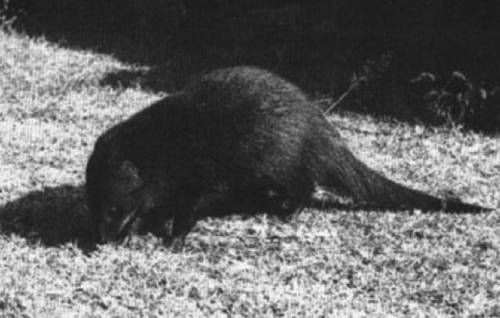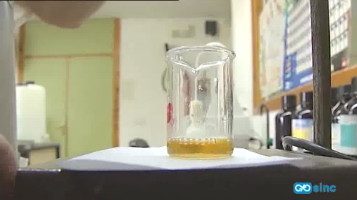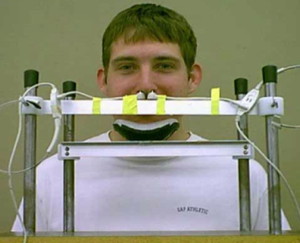Science
How the Marsh Mongoose catches prey

The Marsh Mongoose (Atilax paludinosus), also known as the African Water Mongoose, has an unusual method of catching its favorite food (birds). It makes its butt look like a piece of ripe fruit, which tempts birds over to investigate — and fall right into its trap. Jonathan Kingdon, author of East African Mammals, explains:
According to Animal Diversity Web, the Marsh Mongoose also has another odd trick:
Goes to show that you really can't compete with Nature for weirdness.
Posted By: Alex - Sun Sep 16, 2012 -
Comments (5)
Category: Animals, Freaks, Oddities, Quirks of Nature, Science
Singing Gibbons on Helium
I think a study of helium-sniffing singing gibbons qualifies as weird science. Link to the original article in the American Journal of Physical Anthropology. And you can hear the gibbons singing with and without helium either at eurekalert.org, which has the sound files posted, or in the Newsy Science video below.
Posted By: Alex - Sat Aug 25, 2012 -
Comments (6)
Category: Animals, Music, Science, Experiments
Using your kid as a research subject
Scientists who use their own children as experimental subjects is a recurring theme in weird science. It doesn't happen so often that it's no longer weird. But it definitely does happen.I touched briefly on the subject in Electrified Sheep
Now recently in the news we have Dr. Melvin Morse, a pediatrician and specialist in near-death experiences, who's been accused of waterboarding his 11-year-old stepdaughter in order to bring her to a "near-death state" so that he can study her. For the record, he's denying the charges. [CBS News]
Posted By: Alex - Thu Aug 23, 2012 -
Comments (6)
Category: Science, Children
A solution to global warming
Spanish researcher Jiménez Aguilar has proposed that a substance that's cheap and readily available — urine — might be able to soak up excess carbon dioxide in the atmosphere. He says, "For every molecule of urea in urine, one mole of ammonium bicarbonate is produced along with one mole of ammonia, which could be used to absorb one mole of atmospheric CO2." His idea is to place urine-based filters in chimneys, forcing exhaust gases to pass through the urine, and so remove the CO2. He imagines urine filters for cars as well as domestic and industrial chimneys. [alphagalileo.org]
Posted By: Alex - Wed Aug 22, 2012 -
Comments (8)
Category: Science, Body Fluids
Nostril Dominance
People are either right-handed or left-handed. But are people also left-nostriled and right-nostriled? Yes, they are — as reported in an article published in the journal Laterality (Mar 2005). From the study:Result: The present data support these predictions: for both left-handers and right-handers the nostril that had the significantly greater airflow was ipsilateral to the preferred hand almost 60% of the time.
The researchers also discovered that people are pretty much useless at self-determining their own nostril dominance. (i.e. It's very hard to tell which nostril you're breathing more air through.) So they used a gadget that measured airflow into each nostril to get an accurate measure of nostril dominance.

Posted By: Alex - Sat Aug 04, 2012 -
Comments (7)
Category: Body, Science, Experiments
The Sound of the Northern Lights Clapping
People have long reported that they've heard strange clapping sounds coming from the Northern Lights. But scientists tended to ignore these reports. The people hearing the sounds were told they were imagining them, or that the sounds were coming from sources such as trees or falling ice. But now Finnish researchers at Aalto University have recorded the Aurora Borealis actually making these snapping/clapping sounds, and have confirmed (to their satisfaction) that the sounds couldn't have been coming from anywhere else. More info at space.com and at the researcher's website.
Posted By: Alex - Sat Jul 28, 2012 -
Comments (8)
Category: Nature, Natural Wonders, Noises and Other Public Disturbances of the Peace, Science
The sound of copulating flies
In order to test the theory that noisy copulating animals are at greater risk of being found and eaten by predators, German researchers mounted "dead, noiseless fly pairs" on the ceiling of a shed. The bats that lived in the shed ignored them. But when the researchers played the sound of copulating flies through loudspeakers, the bats attacked the loudspeakers. So, theory proven!Max-Planck-Gesellschaft has a video of the bats attacking the speakers, but unfortunately the video has no sound. And below is a youtube video of some copulating flies -- but again, you can't hear the flies, just some people in the background. So I still don't know what copulating flies sound like.
Posted By: Alex - Fri Jul 27, 2012 -
Comments (3)
Category: Animals, Insects and Spiders, Science, Experiments, Sexuality
Old x-ray of a foot in a boot
Circa 1922. Not particularly weird, but an interesting x-ray nonetheless. From The Outline of Science by J. Arthur Thomson.
Posted By: Alex - Wed Jul 18, 2012 -
Comments (13)
Category: Science, Feet
Science as a girl thing
EU bureaucrats, in their great wisdom, decided that the way to encourage teenage girls to pursue a career in science was not by appealing to their intelligence and curiosity, but rather by flashing images of high heels, lipstick, and makeup at them, along with the tagline: "Science, It's a Girl Thing." The inevitable outrage followed. (telegraph.co.uk)It was my impression (though I don't have any data at hand to back it up, so I could be totally mistaken) that in some sciences, such as biology and medicine, women are fairly equally represented (perhaps even at risk of becoming over-represented). So in those cases science already is a "girl thing." It's the physical sciences, such as electrical engineering, that still have trouble attracting women.
Posted By: Alex - Fri Jun 29, 2012 -
Comments (5)
Category: Science, Gender
Human falling into lava lake: a scientific experiment
Some researchers wanted to know what would happen if a person fell into the lava lake of the Erta Ale volcano in Ethiopia. Would the force of the impact be enough to break through the thick crust, or would the person simply lie on top of the crust and get toasted?To answer this important question, the researchers used a 30kg bag of trash as a stand-in for a human and threw it into the lava, from a height of 80 meters. Watch the video to see what happened. If they're true mad scientists, they'll find a way to repeat the test with a human body.
Posted By: Alex - Wed Jun 27, 2012 -
Comments (15)
Category: Science, Experiments

| Who We Are |
|---|
| Alex Boese Alex is the creator and curator of the Museum of Hoaxes. He's also the author of various weird, non-fiction, science-themed books such as Elephants on Acid and Psychedelic Apes. Paul Di Filippo Paul has been paid to put weird ideas into fictional form for over thirty years, in his career as a noted science fiction writer. He has recently begun blogging on many curious topics with three fellow writers at The Inferior 4+1. Contact Us |




